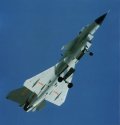AmiGanguli
Junior Member
This is purely speculation (as with all of us, I think), but I think the J-10 will be deployed in reasonable numbers, but it will be succeeded more quickly than typical of the West or of China in the past.
I think (again, mostly my own assumption) they're looking to build an air force comparable to the U.S. in the 2040-2050 time frame. In order to do that they need to gradually build both their R&D and production capability.
Figure a new fighter every 10 years, so J-10+1 around 2014, j-10+2 around 2024, etc. That's achievable, given that the J-xx has been under work since the 1990s.
Quantity-wise, it's wasteful to produce too many planes now, but you need to gradually increase production capacity to about 400/year in 2050. A total production of about 700 to 1000 J-10s by 2014 would seem like a sane number.
So it would be seen as a full-production fighter given the size of the PLAF today, but if you were looking back from 2050 it would seem very much like a transitional plane produced in moderate numbers.
By comparison, I think the USAF has about 2200 F-16s.
... Ami.
I think (again, mostly my own assumption) they're looking to build an air force comparable to the U.S. in the 2040-2050 time frame. In order to do that they need to gradually build both their R&D and production capability.
Figure a new fighter every 10 years, so J-10+1 around 2014, j-10+2 around 2024, etc. That's achievable, given that the J-xx has been under work since the 1990s.
Quantity-wise, it's wasteful to produce too many planes now, but you need to gradually increase production capacity to about 400/year in 2050. A total production of about 700 to 1000 J-10s by 2014 would seem like a sane number.
So it would be seen as a full-production fighter given the size of the PLAF today, but if you were looking back from 2050 it would seem very much like a transitional plane produced in moderate numbers.
By comparison, I think the USAF has about 2200 F-16s.
... Ami.

